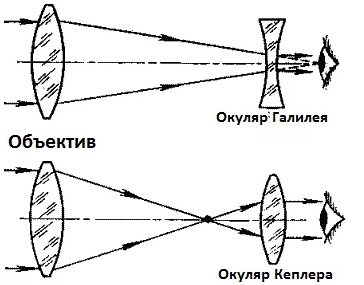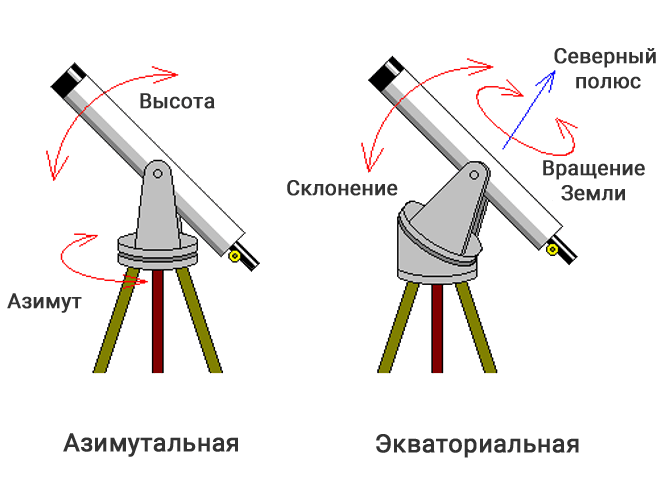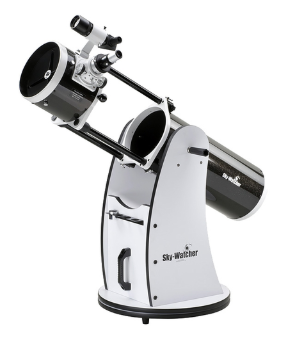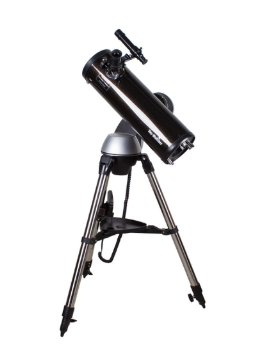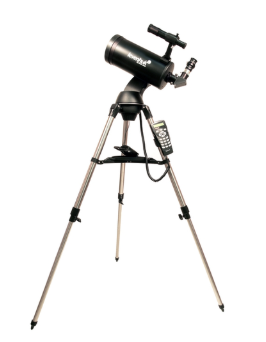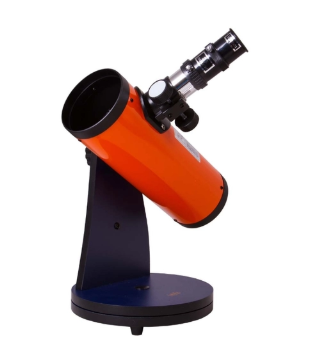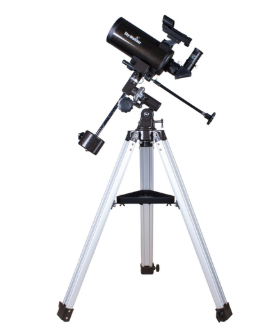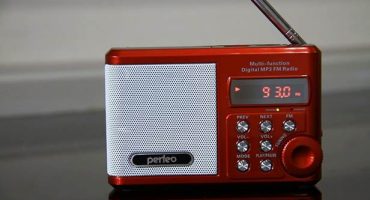Gone are the days when amateur astronomers independently made their own telescopes. Now on sale are many devices of various systems. To choose the best telescopes in their classes, you need to know their optical characteristics and the types of mounts used.
The article introduces the main types of telescopes and gives recommendations on how to choose the necessary model.
| Category | Title | price, rub. | Short description |
|---|---|---|---|
| The best versatile telescopes for beginners | LEVENHUK Skyline Travel 50 | 5990 | Designed to observe only bright celestial objects: the moon, planets, the brightest stars. |
| Sky-Watcher BK 705AZ2 | 9695 | Aperture sufficient for observations of nearby galaxies and star clusters. | |
| Celestron PowerSeeker 114 EQ | 13490 | Can be used for photography with shutter speed. | |
| The best telescopes for observing deep space | Sky-Watcher Dob 8 ″ (200/1200) Retractable | 38990 | A model to start exploring deep-space objects at a reasonable price. |
| Meade LightBridge 16 ″ f / 4.5 Truss-Tube Dobsonian | 199990 | Due to the large diameter, it allows you to get a color image of objects in outer space. | |
| Top Auto Guided Telescopes | Sky-Watcher BK P1145AZGT SynScan GOTO | 37990 | The choice for lovers who do not want to waste time searching for astronomical objects. |
| LEVENHUK SkyMatic 127 GT MAK | 61100 | Selected optical design provides compactness and mobility in combination with high quality image. | |
| Best telescopes for kids and teens | Sturman F30030 TX | 1340 | Achromatic lens. It can be used as a telescope. |
| LEVENHUK LabZZ D1 | 3890 | A relatively large mirror allows you to see many celestial objects. | |
| Best telescopes for travelers | Sky-Watcher BK MAK90EQ1 | 24295 | Fully consistent with the tasks of astronomical tourism. |
Types and characteristics of telescopes
By the method of collecting light, they can be divided into three large groups: refractors (lens), reflectors (mirror), combined (mirror-lens).
Refractors
The first visual devices invented by mankind to observe distant objects. The time of invention is unknown. The first to observe the sky it was used by the Italian scientist Galileo in the 17th century.
Principle of work: the light is collected by a positive lens. The eyepiece is a negative lens. The result is a direct, non-inverted image that suffers greatly from chromatic (color) distortions. In addition, at high magnification, the viewing angle is very small.
The German scientist Kepler improved the scheme by replacing the negative lens with a positive one in the eyepiece. In this case, an inverted image is formed, which is not important for observations of celestial bodies. The image is less prone to chromatic aberration, and the viewing angle is larger.
Over time, the diameter of the lens increased, but chromatic aberration increased. To eliminate it, the focal length was increased. The length of the telescopes increased and reached a record 98 meters by the end of the 17th century. It was almost impossible to observe in such a device.
In the mid-18th century, an achromatic lens was created, devoid of color aberrations. Consists of two glued lenses: positive and negative. Achromats or three-lens apochromats are used in modern refractors. They are even less prone to aberrations.
Reflector
Appeared in the 60s of the 17th century. Here the image is focused by a concave mirror.The image it focuses is reflected by another mirror and viewed through the eyepiece. The scheme is practically devoid of chromatic and spherical aberrations, so the reflector quickly became the main astronomical instrument.
There are two main types of reflectors:
- Newton's system. Focused rays are reflected by a flat mirror to the side and through the hole in the wall of the case fall into the eyepiece.
- Cassegrain system. Focused light is reflected from the convex secondary mirror and through the hole in the center of the main one enters the eyepiece. The design is less technological due to the hole in the mirror. It is not widespread, as it suffered from geometric aberrations.
Due to the design features of reflectors, regular adjustment of its optics is required - adjustment. During it, the relative position of the primary and secondary mirrors is adjusted to eliminate distortion.
Mirror-Lens Systems
In the first half of the 20th century, mirror-lens systems appeared. Here, a spherical main mirror is used, in contrast to reflectors, in which, to prevent aberration, it is necessary to produce a parabolic complex in manufacture. They are compact, airtight, have a good angle of view and a large aperture. They have practically no image aberration. However, the lenses used have a complex road surface, which leads to the high price of the entire device. Therefore, among amateurs, they are not very common.
In the Schmidt-Cassegrain system, the main and secondary mirrors are spherical, which eliminates the appearance of chromatic aberrations. Geometric distortions are corrected by a Schmidt plate with a surface of a special shape, which is installed at the pipe cut. Professional astronomers believe that this type of instrument is the best for astrography.
Aperture (diameter) of the lens
One of the main characteristics. The amount of light entering the device depends on it. The more light a lens or mirror collects, the weaker astronomical objects can be captured. Refractors cannot have a lens diameter greater than one meter, since the glass will not withstand its own weight. All large modern appliances are reflectors. Their aperture reached 10 meters and are being built with an even larger size.
Objects of observation of an amateur - planets, the moon, large star clusters, nearby galaxies, comets. For such purposes, it is enough to purchase a reflector with an aperture of 120-150 mm or a refractor with an aperture of 90-100 mm.
If an amateur is fond of observing deep-space objects, he can acquire a reflector with a mirror size of up to 400 mm. This technique is already used for scientific observation of the sky.
Focal length
This is the distance at which the rays of light are focused, reflected from the main mirror or refracted in the lens of the lens.
For an amateur appliance, the optimum value is 900-1000 mm. In a reflector tube of a greater length, air currents can be generated that distort the image.
The devices of the mirror-lens circuit are spared from this drawback. With an equal focal length, their size is two times smaller.
Magnification factor
An indicator giving an idea of how many times the optical system increases the object in question.
The magnification formula: G = F / f, where G is the magnification, F is the focal length of the lens, f is the focal length of the eyepiece. The greater F and less f, the stronger the increase. For example, if F is 1000 mm, f is 40 mm, the system has a 50x magnification.
With the help of an additional element - Barlow lenses, magnification can be done more. If you place this scattering lens in front of the eyepiece, F will increase by the magnitude of its magnification. Then the formula will take the form Г = FxF / f, where A is the multiplicity of the Barlow lens.
The increase cannot be infinitely increased. With a large magnification, the picture becomes dull and non-contrast, and the viewing angle is significantly reduced. The slightest disturbance in the atmosphere distorts the image.It was experimentally established that the maximum magnification for comfortable visual observation is 2.5D, where D is the diameter of the lens or main mirror in millimeters.
Mount Types
Mounting - a specially designed movable support on which the observing device is fixed. It provides accurate guidance on the selected area of the sky and tracking of the object of observation.
There are two main types: azimuthal and equatorial.
Azimuthal
Here, rotation is carried out along two axes: height and azimuth. The simple design reliably fixing the case. All modern giant reflectors are mounted according to the azimuthal scheme, since only it is able to withstand their weight.
A popular Dobson mount among astronomers, specially designed for Newton’s large reflectors, it’s also azimuthal. Such designs are compact due to the lack of protruding counterweights and additional designs. Easily disassembled, taking up minimum space during storage.
There is one drawback - but significant: rotation of two axes is necessary to accompany the observed celestial body. With visual observation, this can be tolerated. However, when photographing with a slow shutter speed, the image will appear blurry. The solution is the acquisition of automatic control and tracking systems. They are on sale, but expensive.
Equatorial
One axis here is parallel to the Earth axis, the second is perpendicular to it. For tracking, it is enough to rotate the telescope around the axis at a speed of one revolution per day. To automate this, it is enough to use the clockwork. This is very convenient when photographing weak astronomical objects with a shutter speed of several tens of minutes or even hours.
The main drawback is that the mount is more bulky, complex and less mobile. Often equipped with counterweights mounted on remote guides. They can be easily touched at night and knock down the setting.
The equatorial mount is 1.5 to 2 times more expensive than the azimuth one.
Price
The range of prices for refractors is very large. Devices of a familiarization level can be purchased on average for 1,500 rubles, but you can find models worth 1,000,000 rubles. The average cost is in the region of 20,000 rubles and depends on the characteristics of the optics and the type of mount.
Prices for reflectors start at 4,000 rubles for the simplest model. Models with an aperture of 400 mm cost from 200,000 rubles, with a mirror size of 130 mm - 18,000-25,000 rubles.
For a powerful mirror-lens device with an aperture of 80-150 mm, you will have to pay from 20 to 110 thousand.
Telescope Rating
The presented telescope rating contains the models most bought in the spring of 2019. Aperture and focal length are given in millimeters, prices in rubles.
The best versatile telescopes for beginners
These devices are simple and unpretentious. Despite the low price, they provide a good image. Always included in the top sales.
LEVENHUK Skyline Travel 50
Refractor:
- aperture: 50
- focal length: 360
- useful magnification: 8x-100x
- azimuth mount
- optical finder
- average price: 5990
Advantages: lightness, compactness, additional accessories: Barlow lens, two eyepieces, a backpack for carrying.
Disadvantages: designed to observe only bright celestial objects: the moon, planets, the brightest stars. Insufficient aperture and small aperture.
Conclusion: one of the most balanced instruments for exploring the starry sky. You can watch the sky without leaving your home.
Sky-Watcher BK 705AZ2
Achromat Refractor:
- aperture: 70
- focal length: 500
- Max. effective magnification: 140x
- azimuth mount
- optical finder
- average price: 9695
Advantages: achromat gives a good image, free from aberrations. Aperture sufficient for observations of nearby galaxies and star clusters.
Disadvantages: can not be used as an astrograph.
Conclusion: a good telescope for novice astronomy lovers
Celestron PowerSeeker 114 EQ
Newton circuit reflector:
- aperture: 114
- focal length: 900
- effective magnification 16x-269x
- equatorial mount
- optical finder
- average price: 13,490
Advantages: high-quality, having a significant aperture model. Can be used for photography with shutter speed.
Disadvantages: large enough size, the need for periodic alignment.
Conclusion: meets all the needs of a novice astronomy lover.
The best telescopes for observing deep space
These devices allow you to observe objects that are many light years from the observer. Equipped with large, by amateur standards, main mirrors (up to 400 mm). They are significant in size. Used with Dobson mount. It is convenient to carry out visual observations with it. However, photographing requires expensive equipment for automatic search and tracking.
To fully realize the capabilities of the instruments, it is desirable that the observer has an equipped amateur observatory.
Sky-Watcher Dob 8 ″ (200/1200) Retractable
Newton circuit reflector:
- aperture: 203
- focal length: 1200
- magnification: 34x-406x
- dobson mount
- optical finder
- average price: 38,990
Advantages: sufficient compactness due to the folding case. Reasonable cost with great opportunities. Easy transportation.
Disadvantages: only visual observations can be carried out. The complexity of observations in winter due to the long period of temperature equalization.
Conclusions: a model for starting the study of deep space objects with a reasonable price.
Meade LightBridge 16 ″ f / 4.5 Truss-Tube Dobsonian
Newton circuit reflector:
- aperture: 406
- focal length: 1829
- Max. effective magnification: 950x
- dobson mount
- red dot finder
- average price: 199990
Advantages: Due to the large diameter, it allows you to get a color image of objects in far space. Despite its considerable size, it is easily transported. Equipped with a fan to prevent fogging of the mirror.
Disadvantages: there is no automatic tracking system.
Conclusions: designed for professionals, can be used for space research.
Top Auto Guided Telescopes
Devices equipped with automatic search for objects and tracking them in the process of observation. The memory contains the coordinates of several tens of thousands of astronomical objects. The disadvantage is the high price.
Sky-Watcher BK P1145AZGT SynScan GOTO
Newton circuit reflector:
- aperture: 114
- focal length: 500
- magnification 19x-228x
- azimuth mount
- optical finder
- automatic guidance
- number of objects in memory: 42900
- average price 37,990
Advantages: compact, with powerful optics. The mechanism is powered by AA batteries for mobility. A large number of objects for observation in memory.
Conclusion: a good choice for lovers who do not want to spend time searching for astronomical objects.
LEVENHUK SkyMatic 127 GT MAK
Mirror-Lens:
- optical design: Maksutov-Cassegrain
- aperture: 127
- focal length: 1500
- Max. effective magnification: 250x
- azimuth mount
- optical finder
- automatic guidance
- average price: 61100
- number of objects in memory: 42000
Advantages: the selected optical design provides compactness and mobility in combination with high quality image. Automatic tracking allows you to use it as an astrograph.
Disadvantages: high cost, difficult adjustment.
Conclusions: a convenient and compact tool for conducting both visual and photographic observations.
Best telescopes for kids and teens
Simple and reliable models, the purpose of which is to open to children the world of the starry sky. Therefore, the devices do not have complex optical systems, and the dimensions allow children to easily use them without the participation of adults.
Sturman F30030 TX
Achromat Refractor:
- lens diameter: 30
- focal length: 300 mm
- useful magnification: 4x-75x
- azimuth mount
- no finder
- average price: 1340 rubles
Advantages: lightness, compactness, mobility. Achromatic lens. It can be used as a telescope.
Disadvantages: no for this price.
Conclusion: ideal for the first acquaintance of the child with the night sky.
LEVENHUK LabZZ D1
Reflector:
- aperture: 76
- focal length: 300
- magnification: 100x
- dobson mount
- average price: 3890
Advantages: compact, convenient, always ready to use. A relatively large mirror allows you to see many celestial objects.
Disadvantages: requires periodic alignment.
Conclusion: a good and inexpensive children's reflector.
Best telescopes for travelers
Astronomical tourism, which is gaining popularity, requires compact, fast-mounted, easy-to-transport, lightweight products with good optical characteristics. For such purposes, mirror-lens devices are ideal.
Although, of course, the decision is what kind of telescope to take with you on the road, each traveler decides for himself.
Sky-Watcher BK MAK90EQ1
Mirror-Lens:
- optical design: Maksutov-Cassegrain
- aperture: 90
- focal length: 1250
- Max. effective magnification: 180x
- equatorial mount
- red dot finder
- Weight: 1.37 kg
- Average price: 24,295
Advantages: good optics, lightness, mobility.
Disadvantages: the kit does not include motor drives for automatic maintenance. They need to be purchased separately.
Conclusion: fully consistent with the tasks of astronomical tourism.

